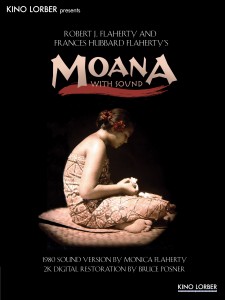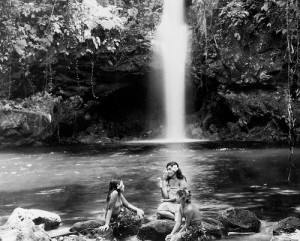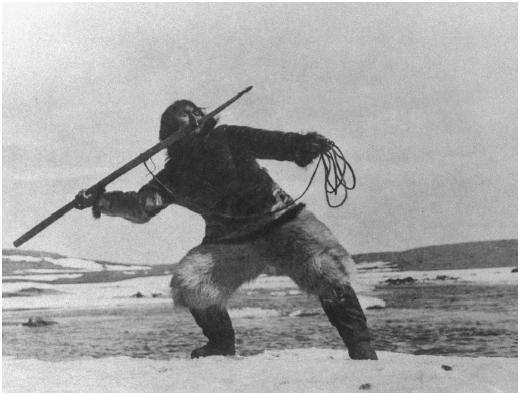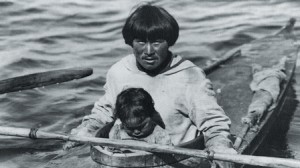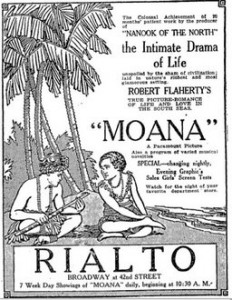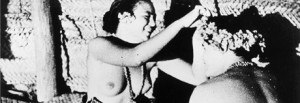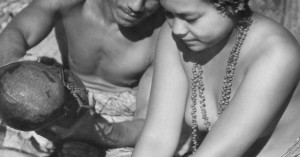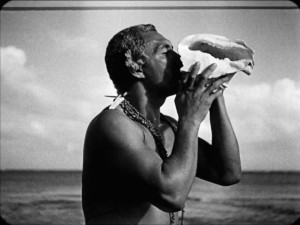From the March 2016 issue of Artforum, where it appears under the title “Given Voice”. — J.R.
“Until recently,” wrote anthropologist Jay Ruby thirty-odd years ago, “the scholarship and popular press surrounding [Robert J.] Flaherty have tended toward two extremes—portraying him in mythical terms and ‘worshipping’ his films or debunking them as fakes and frauds and castigating him for a lack of social and political consciousness.” But the more balanced view of “Flaherty as a man of his time and culture” that Ruby saw succeeding these extremes still hasn’t fully taken hold, perhaps because the very meaning of the term “documentary” is still being debated. Even when we smile (or flinch) at some of Flaherty’s romantic conceptions, the comprehensive theoretical questions raised by his methods are ones we still can’t confidently say we’ve resolved.
“Documentary” was reportedly first used in English by the Scottish filmmaker John Grierson in a pseudonymous rave review of Flaherty’s second feature, Moana (1926). (Seeking to duplicate the success of Nanook of the North [1922], but in warmer climes, Flaherty set sail for the South Seas the following year, his entire family in tow, to shoot a film in Samoa.) Significantly, Grierson employed the novel term to register one of the film’s subordinate virtues: “Of course Moana, being a visual account of events in the daily life of a Polynesian youth, has documentary value,” he noted. “But that, I believe, is secondary to its value as a soft breath from a sunlit island, washed by a marvelous sea, as warm as the balmy air.” His second sentence may sound more dated than his first, yet his evocation is more convincing than his description. Even when we take into account the sound track added to the original silent film by Flaherty’s youngest daughter, Monica, half a century after its release, the film’s sensuality trumps its documentary interest. Indeed that evocative and superbly integrated sound track—created between 1975 and 1980, with the aid of Richard Leacock and the encouragement of Jean Renoir and consisting of indigenous songs Monica originally heard as a toddler while her parents were shooting the film, meticulously post-synched Samoan dialogue (based on lip-readings of the silent footage by Samoan speakers on the island of Savai’i and in Hawaii), a judicious selection of sound effects, and a rich ambient soundscape provided by Leacock’s field recordings–paradoxically sustains Grierson’s judgment at the same time that it seemingly enhances the film’s documentary value. (Flaherty’s pioneering use of panchromatic rather than orthochromatic film stock does wonders for the film’s sensual impact, especially regarding its sculptural textures of skin, clouds, and sea.)
This balance might have shifted if Monica Flaherty had subtitled the Samoan dialogue that we hear, which would have been the expected “documentary” procedure. But because neither her father nor her mother Frances (the film’s uncredited cowriter and codirector) spoke the language, depending entirely on an interpreter, and because she wanted to preserve the integrity of the film as subjective expression, Monica neither added to nor subtracted from the visual material: The objective meaning of the dialogue would have created a distracting surplus. Not knowing its meaning obliges us to respond more intuitively and less intellectually, as the Flahertys did. And appropriately enough, the sound track brings more warmth as well as more artifice to the mix: more artifice because the sounds were recorded many decades later, by other people, yet more warmth because the sensuality and presence of the images are enhanced. ”Oh, if we could only take back with us the singing,” Frances Flaherty had written in 1924. “Not the songs, but the singing.”
One could indeed argue that sound was already a key part of Flaherty’s universe long before he was able to record it for his films. One characteristic intertitle of Nanook of the North reads: “The shrill piping of the wind, the rasp and hiss of driving snow, the mournful wolf howls of Nanook’s master dog typify the melancholy spirit of the North.” From this perspective, Monica’s aural intervention might be seen as providing the sound track the film lacked owing only to the technological limitations of the times. In the forty- minute “short history” of Moana with Sound appended by Bruce Posner (who oversaw the digital restoration) to the film’s recent home-video releases, we learn that the sound recording and mixing, praised equally by Virgil Thompson and Kevin Brownlow, took years of intricate work. Indeed, sixteen years elapsed between Leacock’s recording of the sound in Samoa and the premiere of a provisional 16-mm version of Moana with Sound at the Cinémathèque Française in 1981. And thirty-three more years would pass before Posner and his team finally integrated Monica Flaherty’s sound track with a complete 35-mm nitrate print of her father’s original film, now digitally restored.
***
The ad for Moana that appeared in the New York Times when the film premiered at the Rialto Theatre on February 7, 1926, is a splendid example of nineteenth-century utopian idealism comically rubbing shoulders with twentieth-century technology and materialism: “The Colossal Achievement of 20 months’ patient work by the producer of / ‘NANOOK OF THE NORTH’ / the Intimate Drama of Life unspoiled by the sham of civilization; laid in nature’s richest and most glamorous setting. / Robert Flaherty’s TRUE PICTURE-ROMANCE OF LIFE AND LOVE IN THE SOUTH SEAS. /‘MOANA’ / A Paramount Picture / Also a program of varied musical novelties / SPECIAL—changing nightly. / Evening Graphics’ Sales Girls’ Screen Tests / Watch for the night of your favorite department store.”
The Flahertys, for their part, were bent on celebrating a civilization untouched by government, traders, or missionaries, yet Frances Hubbard Flaherty’s first impression of Samoa conjures a land more mythical than unspoiled: “The people we met when we arrived were like creatures of another time,” she mused. “We remembered the words of Henry Adams, friend of Robert Louis Stevenson, who with John LaFarge the painter, lived in Samoa in the 1880s: ‘It is a deep wonder to me that I have not been told that here is rustic Greece of the Golden Age, still alive, still to be looked at.’”
Walker Evans once aptly noted that Flaherty was closer to Sherwood Anderson’s generation than to Ernest Hemingway’s: “He certainly had one foot in an age of innocence.” And the contradiction of Flaherty’s romantic view of Natural Man being conveyed with the most up-to-date equipment–sixteen tons of it shipped to the Samoan island of Savai’i (courtesy of Paramount Pictures, which was hoping for “another Nanook”), including a 35-mm projector and a lab for developing film stock–was already evident in Nanook, as was the filmmaker’s penchant for cosmetic fictionalizing. The delightful detail of Nanook (whose real name was Allakariallak) biting into a phonograph record allegedly belonging to a trader was staged with Flaherty’s own phonograph and record; the eponymous hero’s alleged wife “Nyla” was actually Flaherty’s Inuit mistress; and Nanook’s hunts with spear and harpoon were undertaken because the rifles he normally used were deemed too modern. Even the size of his igloo had to be doubled to make room for the camera. Yet, as the late Gilberto Perez pointed out, Flaherty’s occasional acknowledgment of his own artifice—most memorably, when he films his hero cutting a window from inside his igloo while Flaherty frames him through his viewfinder—is what validates Nanook as a documentary. Nanook’s delight in presenting himself to the camera—echoed in the shot of his son (or a boy playing his son) ostentatiously relishing the taste of castor oil—is matched only by Flaherty’s joy in presenting him.
Moana has less of this joyfulness, even if it adds radiant close-ups and more elaborate, loving pans to Flaherty’s visual vocabulary, because this time Flaherty, who was already pushing forty when he began shooting Moana, was searching for exploitable subjects to film, not for ways to film what he already knew, and participation from the Samoan natives was harder to elicit. (He projected Nanook and other films for many of them, and must have felt disappointed to discover that they preferred the 1920 Der Golem.) Most of the production history of Moana consists of an ongoing tragicomedy of looking for daily struggle in an environment where little existed, repeated hunts for a “photogenic” heroine (who would be required to relinquish her contemporary garb for breast-exposing siapos), and Flaherty nearly dying after drinking water contaminated by silver-nitrate deposits from his makeshift lab.
Perhaps Flaherty’s biggest problem of all was reconciling his idyllic notions of the Samoans as an uncorrupted “race” (a recurring term in the intertitles of both Nanook and Moana) with the everyday complications of shooting a commercial feature in a corrupt New Zealand mandate lorded over by a Kurtz-like German chieftain who called himself “King of Savai’i” and entertained the natives regularly by singing opera. When it came to filming the climactic sequence in which Moana is tattooed in a rite of passage to manhood — a ceremony by then no longer actually observed by the islanders — Ta’avale, who played Flaherty’s young Samoan hero, had to be paid handsomely to undergo the painful tattooing sessions.
Yet what emerges from all this contrivance, as in Nanook, is a passionate engagement with the people who are filmed, as opposed to the characters or actors. As André Bazin wrote in 1952, “There is no way of completely understanding the art of Flaherty, Renoir, Vigo, and especially Chaplin unless we try to discover beforehand what particular kind of tenderness, of sensual or sentimental affection, they reflect. In my opinion, the cinema more than any other art is particularly bound up with love.” He might have added that Renoir and Vigo share with Flaherty a capacity for making the usual distinctions between documentary and fiction irrelevant.
Released theatrically in the US for the first time this past fall, Moana with Sound is now available on Blu-Ray and DVD from Kino Lorber.

